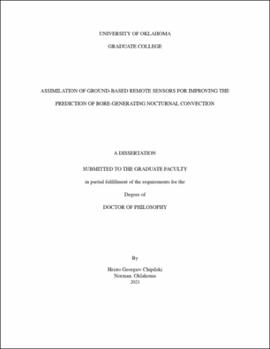| dc.description.abstract | Advances in Numerical Weather Prediction (NWP) require a synchronous improvement in the structure of the underlying Global Observing System (GOS). However, recent progress toward high-resolution modeling has not been accompanied by a commensurate increase in the number of available observations. For more than two decades, the meteorological community has identified a striking gap in the observational coverage within the Planetary Boundary Layer (PBL). This gap is particularly detrimental for convective-scale models whose forecasts depend strongly on the initial PBL structure. In an effort to confront the existing observational limitations, scientists and engineers have begun to rapidly develop novel ground-based remote sensing technology. Its ability to describe the diurnal evolution of the PBL is expected to bring large benefits for the next generation of convective-scale NWP models. In this dissertation, we support this hypothesis by showing how ground-based remote sensing instruments can improve the forecasts of bore-generating nocturnal convection observed during the Plains Elevated Convection at Night (PECAN) field campaign.
To evaluate the forecast impact of these novel instruments, we first develop an object-based algorithm for the identification and tracking of convective outflow boundaries in NWP models. The most distinct feature of the algorithm, which sets it apart from previously suggested frameworks, is its ability to seamlessly analyze density currents and bores, both of which play an important role in the dynamics of bore-generating nocturnal convection. The unified classification of these morphologically different phenomena is achieved through a multivariate approach combined with appropriate image processing techniques. The tracking component of the algorithm utilizes two dynamical constraints, which improve the object association results in comparison to methods based on statistical assumptions alone. We use a retrospective PECAN case study to illustrate how the newly developed algorithm can objectively analyse both the structure of atmospheric bores as well as the environmental conditions in which they form.
The original version of the algorithm is then extended to allow for an object-based, neighborhood verification of the ensemble bore forecasts against data from thermodynamic remote sensors. This new framework is utilized to investigate the impact of different PECAN observations on the forecasts of a bore-driven convective event that took place on 6 July 2015. Specifically, we examine the forecast impacts with respect to (i) the bore environment, (ii) the explicitly resolved bore, and (iii) the bore-initiated convection. Our findings suggest that ground-based remote sensors provide considerable advantages over conventional in situ observations, especially when the retrieved data are assimilated at a high temporal frequency. The clearest forecast improvements are seen in terms of the predicted bore environment where the assimilation of kinematic remote sensors reduces a preexisting bias in the structure of the low-level jet.
Finally, the aforementioned single case findings are generalized by performing systematic experiments with 10 additional PECAN cases that feature a diverse spectrum of convective dynamics. The purpose of these systematic experiments is to compare the forecast benefits coming from different ground-based profiling networks. Aggregated verification statistics demonstrate that the best forecast skill is achieved by simultaneously assimilating in situ and remote sensing profilers, both in terms of the parent convective system as well as the explicitly resolved bore. Our analysis suggests that it is often advantageous to collocate thermodynamic and kinematic profilers. On the other hand, the impacts from single profiler networks tend to be highly flow-dependent, with thermodynamic (kinematic) profilers playing a dominant role in cases with relatively low (high) convective predictability. In addition, deficiencies in the underlying data assimilation (DA) system as well as complexities in the governing moisture dynamics can further limit the efficacy of such networks. | en_US |
